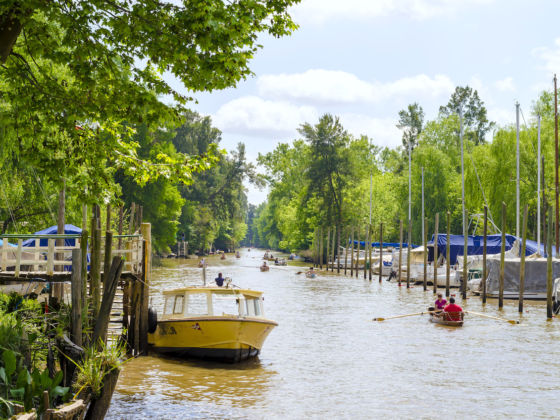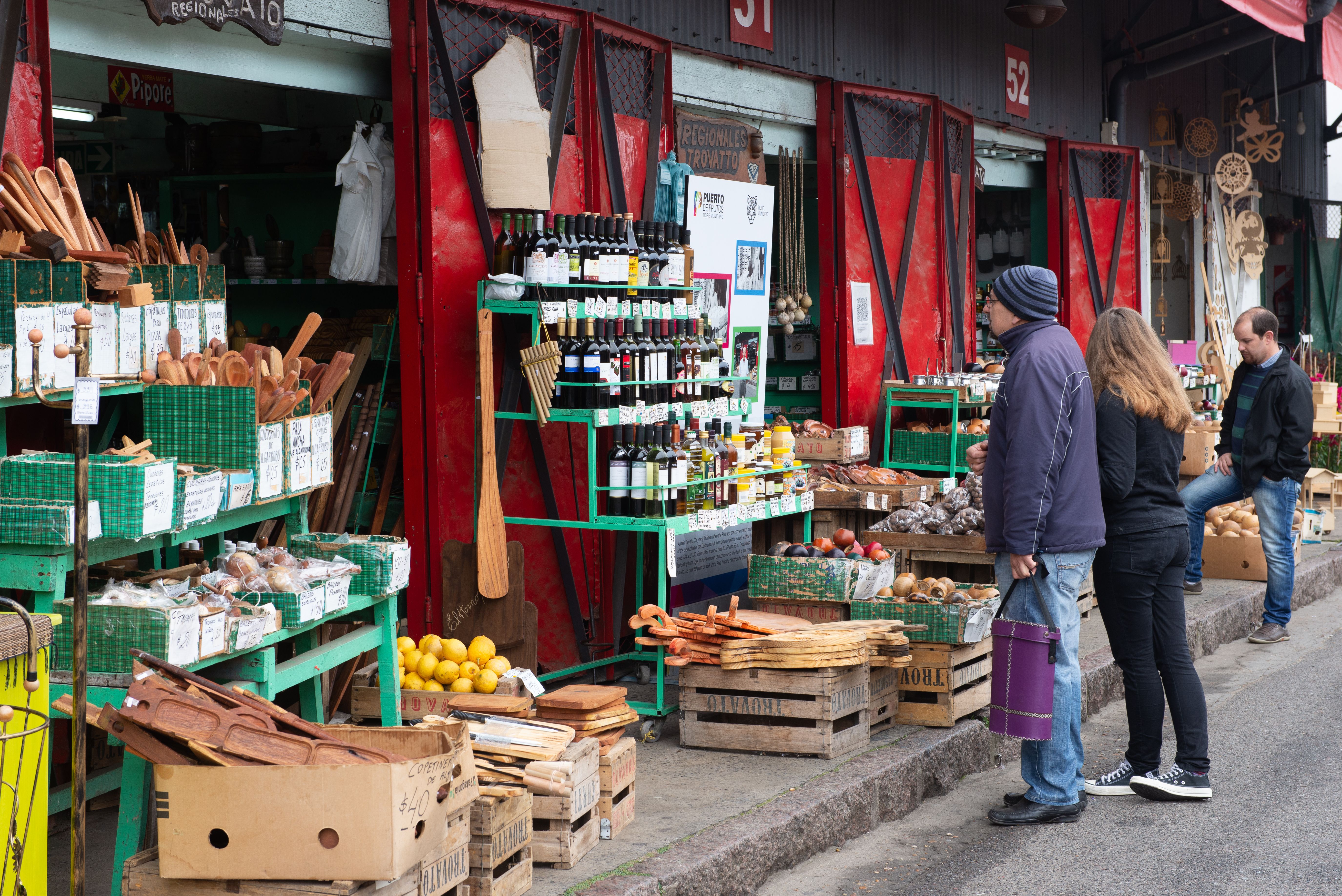Buenos Aires is home to a constantly evolving cultural patchwork built around a range of gastronomy, plenty of parks, and rhythmic excitement. The metropolis sprawls inland while hugging the coast of Rio de la Plata, a large river that separates Argentina from Uruguay. Although water and greenery are present all around Buenos Aires, it can be difficult to forget that you are in a city. Just north of the city, at the crossing of the Rio de la Plata and the Rio Paraná, the land twists its way into a labyrinth of swampy grasslands and islands. This area is the Paraná Delta, the fifth largest delta in the world, and one of the only which flows into a body of fresh water instead of the sea. Exploring these surroundings along the coast is worth it, and easily accessible for a day trip. The islands and the mainland surrounding it make up the town of Tigre, a perfect escape from the craze of Buenos Aires.


How to Escape Buenos Aires for the Day to Tigre, Where Porteños Go to Relax
Porteños, residents of Buenos Aires, have long visited Tigre to take a break from the city, even using it as a retreat from an epidemic of yellow fever in the late 1800s. Tigre’s current reputation as a quiet haven does not reflect its name, which comes from the tigres — jaguars, specifically — that were once a bit too common for comfort throughout the delta. Tigre is where Porteños go to relax, and you should hop on the train from Buenos Aires for an afternoon to join them.
Leaving the city for the delta

Photo: sunsinger/Shutterstock
Tigre is an easy 45-minute train ride from Retiro, Buenos Aires’ main train station, though it can also be reached via bus or with a tour service. You can buy a ticket one-way at the station and buy another when you return. Get yourself a SUBE card at the station and the cost drops from $9 to about $4. Once you exit the train in Tigre, you’ll find yourself next to the town port. Here many small wooden boats called lanchas wait for clients to board their frequent trips around the small inlets of the delta and its many islands. Regular transport is available, as well as tours with various durations and routes. There are different options to make your trip unique, such as bird-watching, fishing, and hiking through the forest with knowledgeable botanists. You can make stops along the way for a bite at a restaurant or for a picnic at one of the rest areas.
The perfect respite from city life is found in the maze of islands and the natural life of the Paraná Delta, accessible only by water. The real beauty of the boat rides around the delta’s narrow ways is that you find yourself in an intimate encounter with nature and the quiet daily life of the people living on the islands, even for just a few hours. You might even catch sight of the grocery, medical, or school boat traveling the waterways to distribute supplies and to transport inhabitants. Many houses on these isolated islands are available to rent on Airbnb, making it possible to try out the lifestyle should you decide to stay overnight.
Getting in tune with nature and the community

Photo: Estudio Pixies/Shutterstock
The pace in Tigre is famously slow compared when with that of Buenos Aires. This is what the Porteños are after, but if you’re a “seize the day” type of traveler, fill your itinerary with outdoor activities during the afternoon. Kayak tours and rentals are available from shops including El Dorado Kayak, turning the ride through the network of waterways into direct communication with the surrounding scenery and wildlife. For being so close to the nation’s bustling capital, Tigre is surprisingly lush and green, with tree-shaded, stilted docks along the waterfront often playing host to a family sitting at the end, having lunch or casually fishing. A short paddle away you could come across a flock of birds, chirping in a frenzied chatter. At home with the natural environment, conversations here linger over a thermos of mate, the traditional tea and social ritual popular in Argentina and nearby countries. You’ll see locals and tourists alike pedaling bicycles along the water and through the quiet streets, stopping to chat with pedestrians or to linger at a cafe in the afternoons. Don’t be shy about asking for a dinner recommendation or for where to tango after the sun goes down.
Cultural buzz and artistic talent

Photo: Diego Grandi/Shutterstock
If the simple thought of setting foot on a boat reduces you to nausea, there is plenty to do on the continente, what locals call the mainland of Tigre. With a history as a popular spot for rich Porteños to visit, the cultural options are not lacking. To its great pride, the only museum in the world about mate is located in Tigre. The Museo del Mate describes the history and customs of yerba mate, the iconic herbal beverage of Argentina. The mate bar on site is the perfect place to try the drink, praised for its multitude of health benefits. It’s thought to help its drinker gain energy, lose weight, and lower blood sugar, among other perks. Whether or not its magic plays out during your stay, it’s at least a delicious way to embed yourself in the Argentinian way of life.
You should also spend an hour or so strolling the Paseo Victoria. This walkable and bikeable path runs along the river and passes many small cafes where you can stop to sip mate while overlooking the water. The Paseo is the ideal way to welcome yourself to the area as many of Tigre’s sights are built along the waterfront of the Luján River and are easily accessible. If you are keen to learn more about Argentina’s maritime presence, the Naval Museum has you covered. To truly step back in time to the Belle Époque, visit the Museo de Arte Tigre, located in an Italian and French-style mansion along the river. Once a social club, the space now holds a small collection of 19th and 20th-century Argentine art. Its grounds by the water are a desirable spot for wedding photoshoots. Regardless of how you get there, the most delicious stop on the path is the Heladería Vía Toscana, known for its artisan ice cream and inviting garden. You can also have a good meal at one of the restaurants and cafes along the Paseo Victorica.

Photo: El Greco 1973/Shutterstock
To cover much of the inland area in the space of an afternoon, rent a bike from one of the vendors near the train station and pedal along the riverfront. One of Tigre’s most visited sights is the Mercado de Frutos, once a fruit market and important agricultural stop in the 1900s. Nowadays a few homemade snacks and small restaurants are available, although the purpose of the market has shifted to artisan crafts. Reed, wicker, wood, and cane furniture are plentiful, and the usual knick-knacks for tourists are sold. For more of a quirky take on the local art scene, Boulevard Sáenz Peña is your best bet. Art galleries, workshops, and studios are scattered along the street, the center of the city’s art district.
For a spike in adrenaline, Tigre’s Parque de la Costa is the largest amusement park in Argentina. Not quite the size of its North American counterparts, it still has a Ferris wheel, roller coasters, and plenty of rides to keep you entertained for an hour or two.